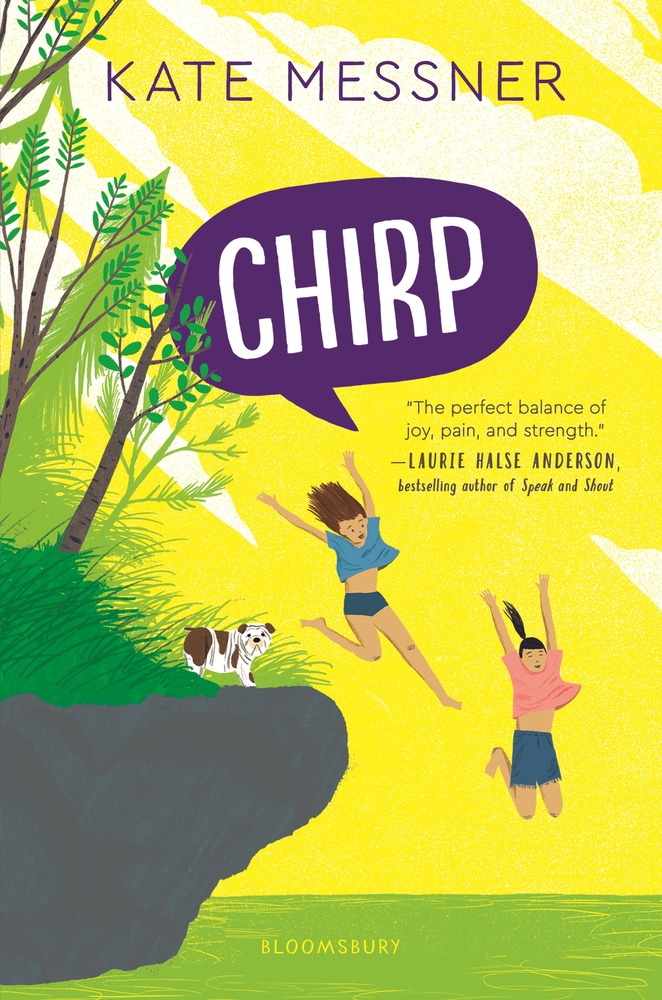by Daria Pipkin
Every character in a novel should serve a purpose, either in moving the story forward or revealing something about the main character. A few months ago I wrote a blog post about Necessary Pets in middle grade books. Here I’ll continue that study by focusing on the dog in Kate Messner’s Chirp–a clear example of how to incorporate an adorable pet with purpose. First, let’s examine what makes a character necessary or unnecessary.
In simple terms, a novel is about one character’s internal struggle and the external plot that forces her to confront that struggle. Every part of the book should in some way impact the plot or the character’s development. An unnecessary character is one who doesn’t really add anything significant to the story, who distracts from the protagonist’s journey rather than either supporting or sabotaging it. The best way to determine if a character is necessary or not is to evaluate how much effort it would take to cut them. If the character can be cut easily without impacting the plot or causing a ripple-effect that leaves a gaping hole in the story, that character is probably unnecessary.
The more characters there are, the harder it is for the reader to connect with the important ones. As authors, we want to make sure every character serves a purpose. This is, perhaps, most difficult with family members. Especially in kidlit, it’s natural for us to want our protagonists to have parents, siblings, friends, and even pets, but how do we make them essential to the story?
Introducing Syd
In Kate Messner’s Chirp, Syd the dog is a necessary character. She’s so important she even made the cover! In the main plot line, the protagonist, Mia, is solving the mystery of who is sabotaging her grandma’s cricket farm, and Syd plays an integral role. This story is about so much more than that, but for the purpose of this post, I’m only going to focus on Syd’s role in the story. (SPOILER ALERT: This post absolutely spoils the ending, so if you want to be surprised by the book, go read it now and then come back.)
We first meet Syd very early, on page 9:
Just then, the office door opened, and a fat sausage of an English bulldog puppy came waddle-running out, barking up a storm.
“Syd!” Gram shouted, shaking her head. “She’s supposed to be the welcome dog, but we’ve obviously got some work to do.”
“You got a dog!” Mia bent to pet Syd, whose huge puppy head looked as if it might tip the rest of her over.
“You got a dog?” Mom said.
Gram ignored her and turned to Mia, who was rubbing Syd’s belly. “She’ll love you forever now. She only ever barks the first time she meets someone.” (9)
We can already guess here that an author as brilliant as Kate Messner isn’t including this dog merely for the cuteness aspect. The detail about her only barking the first time she meets someone is important and is reinforced a few pages later:
As soon as they opened the door, Syd waddle-ran over. As promised, she didn’t bark this time. She wagged her tail, flopped down, and rolled over for a belly rub. (18)
The reader is introduced to this key component of Syd’s behavior as Mia is, so it fits seamlessly into the story.
Keeping Syd on the Page
Syd’s main role in the story comes late in the novel, but Messner needs readers to remember Syd as a part of the world. We’re reminded of Syd about 20 pages later:
Mia was about to ask Gram if she could see the original business plan when Syd came wobble-racing out, looking for love. Mia was tied up with belly rubbing for a good five minutes, and by then, Gram was on her phone. (39)
Then another twenty pages later, we experience Syd’s first-encounter routine all over again, when she meets Mia’s friend Clover for the first time:
When they got to the farm, Syd came wobbling out to greet them, wagging her stub of a tail. When she saw Clover, she stopped and barked like an attack dog.
“Wow. Your dog hates me,” Clover said.
“Syd hates everyone for fifteen seconds or so. After that, she’s your best friend. See?”
Syd was already nuzzling Clover’s shins, looking for love. (61)
The reader has a clear image of how Syd acts around people she’s met before AND how she acts around strangers. Now Messner is ready to use that behavior to affect the plot.
Syd’s First Impact On The Plot
Ten pages later, Mia and her friend Clover already suspect that someone is sabotaging the cricket farm. When they pass by the farm after their warrior camp, this happens:
“Thanks,” Clover said as they walked down the hall. “I finally figured out—” She stopped, and as soon as she did, Mia heard a dog barking. “Is that Syd?” Clover asked. They raced to the cricket farm door.
“Locked.” Clover looked up at the high window above the door. “And it’s dark in there.”
Mia nodded. “Everybody’s gone, remember? That’s why we had to bring all our stuff to Warrior Camp.” Daniel had left for his “just an appointment,” and Gram had told them she was leaving Syd in the office while she ran out to meet with a maybe-investor.
“Then why is the dog so upset?” Clover whispered just as the barking stopped. There was a shuffling sound on the other side of the door. And then voices. (69)
We now know that at least one of the two voices that Mia and Clover overhear belongs to someone who has not met Syd before. When Mia tells her Mom about the incident a few pages later, Syd is clearly a piece of this puzzle:
“Are you sure it wasn’t Daniel? Maybe he forgot something.”
“I mean . . . maybe?” It hadn’t sounded like Daniel, but there had been a big door between them. “But there were two voices. Plus Syd was barking, and she only ever barks at strangers.” (72)
Syd In The Background, But Not Forgotten
After this, Syd falls into the background for a while, with only a couple brief mentions to remind us of her relevant behavior: The first is–you guessed it–about 20 pages later (page 97). Then a long time passes before we see Syd again. Readers are familiar enough to remember Syd after this long stretch:
As soon as they walked in, Syd made a beeline for Mia. Then she spotted Anna, stopped, and burst out barking.
Anna stepped back, but Clover said, “Don’t worry. She used to hate me, too.” Syd had already stopped barking, so Clover bent to love her up. “Remember that, oh, fierce one?” she said as Syd flopped over for a belly rub. (189)
Syd’s behavior when she first meets Anna, but remembers Clover, prepares the reader for Syd’s next important appearance.
Syd In The Climax
Twenty pages later, Syd reappears, and we get to circle back to Syd’s important role of barking at the strangers in the dark farm on page 69. Here, Mia and Clover have caught the two men in the act of their latest episode of sabotage. We’re jumping right into the middle of a climactic scene, where they are confronting the men:
“By spying on her? And on us?” Mia unzipped her duffel bag and yanked out the moose. “We found the bug in your stupid moose’s ear.”
Just then, the cricket-farm door opened, and Syd came racing out, wagging her tail. Mia waited for her to bark at the stranger. But Syd didn’t bark at Mitch. She ran up to him, flopped down on his foot, and rolled over for a belly rub.
Now Mia knew where she’d heard that voice.
“This isn’t your first day here at all!” she said. “You helped him bring in the fruit flies! And I bet you messed with Gram’s thermostat and freezer, too!” (207)
Without Syd, Mia never would have heard the intruders the first time. And she wouldn’t have been able to link the evildoers to both incidents. Syd has fulfilled her purpose for the plot.
Syd At The End
Syd gets another brief mention in the denouement (page 208), before she has one more important role to fill: She prompts the narrator to state the theme of the story. (I did say this story is about much more than saving a cricket farm, right?) After an Open House at the cricket farm, Syd enters the scene:
“Gram [. . .] went to let Syd out of the office. Syd had been banished so she wouldn’t launch a waddle-bark attack on the guests. Poor dog. She’d have to figure out someday that not all strangers were awful and not everybody who gave you a pat on the head was okay.
Mia took a break from cleaning the craft table to rub Syd’s belly while Clover rolled up the banner. (222)
Every story is ultimately about the main character’s internal growth and discovery, but, especially in kidlit, a big pitfall is to come across too preachy. It’s common to have a side character state the theme of the story, but this statement would have come across very differently if it was said by an adult character. Here, Mia isn’t being taught by an adult. Mia is the wise one, who now understands the ways of the world better than the “poor dog”.
Finally, Syd is rewarded for a necessary job well done:
“We’ll still have half an hour if we leave now,” Mia said. “Here, Syd!” She put her paper plate down and let Syd gobble up what was left of her pizza crust. (223)
Now it’s your turn!
- Does your protagonist have a pet? If the answer is yes, why do they have a pet? Is it just because you like animals, or does the pet have a special role to fill in the story?
- If the pet meets all the criteria of an unnecessary character, are you willing to cut it? Or can you find a way to make it necessary?
- Could your protagonist witness a critical event or meet someone important while she’s out walking her dog? Or buying cat food?
- Does he learn something about himself by studying his pet’s behavior, like Mia contemplates why female crickets don’t speak up—or Chirp? Yes, even the crickets perform multiple roles in this story, but to find out how, you’ll need to read the book!

Daria Pipkin writes novels aimed at upper middle grade readers. If she’s sitting down to read or write, there’s probably a dog on her lap. Otherwise, she can typically be found somewhere outdoors in New Mexico. She is a member of SCBWI and two active middle grade writer groups. Find her at dariapipkin.com or on Twitter as @DariaPipkin.
If you enjoyed this blog post, here are some others you might enjoy that explore character development for both primary and secondary characters!


[…] UPDATE: If you liked this post, check out this follow-up post I was honored to write for KidlitCraft: Making Every Character Integral To The Story, Even Pets! Syd in Kate Messner’s CHIRP […]